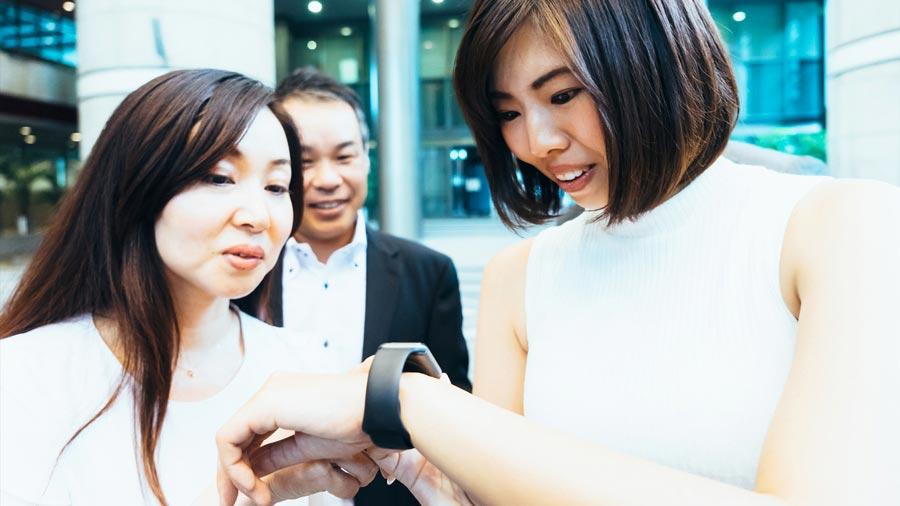Forward-thinking organizations like South by Southwest and the Consumer Technology Association are hastening the rate of adoption for wearable technology at live events.
The new generation of wearables couldn’t be easier to use, incorporating the latest in beacon technology that is able to automatically track an attendee’s location during an event. Here’s a look at how wearables are giving event attendee engagement a giant boost and improving event outcomes for all participants.
Streamlined Event Check-In
Consider this familiar scene: Attendees arrive at an event with great expectations only to be greeted by a long line at registration. It’s an unpleasant way to start a conference—and one that can leave a lasting negative impression.
Wearables dramatically cut—and often eliminate—wait time. Working in tandem with beacons located throughout the show floor and session rooms, they enable attendees to breeze through registration and automatically check into and out of sessions.
Better Networking At Events Many wearables include data analytics and event mobile apps as part of the package. These next-level smart badges enable you to exchange content and contact information virtually in an instant. Attendees don’t have to write everything down on the back of a business card while missing out on opportunities to meet someone new. They don’t have to tote around marketing material, either. The technology does it all for them. They now have the ability to download the material if and when they want it.
Better Networking At Events
Good networking, of course, is key to any event’s success. But let’s face it, not everyone is comfortable starting conversations with people they don’t know. Wearables make the experience so much easier. They enable attendees to see what they have in common with a prospect before engaging for smoother, more natural conversation starters. To protect privacy, these solutions put delegates in control of what information to share, from contact details to demographics. Both attendees must press their badge or “opt in” to exchange contact info. Attendees can also set their badges to anonymous mode anytime they want.
It’s easy to see how wearables will be a game changer for networking. At the end of a jam-packed day, attendees often find themselves struggling to remember all the people they’ve met. Working in sync with a mobile app, new wearables provide an automatic record of the booths attendees visit, the people they spoke to and the locations and times interactions took place. This frees attendees up to enjoy the event—visiting booths and talking to fellow event-goers—while technology does all the tracking for them in the background.
Exhibitor Satisfaction
Wearables don’t just make life easier for attendees. Exhibitors can set the technology to provide real-time alerts when an important prospect enters their booth based on an analysis of attendee profiles and behaviors.
Detailed post-event ROI data and analytics reports add value to sponsorships. Reports can provide critical information on attendees who visited an exhibitor’s booth, such as contact details and demographics. Also included: analysis of where a prospect spent a majority of their time for a better gauge on a prospect’s interest. The result is a spike in satisfaction for sponsors, who capture more leads and have the data they need for more customized sales and marketing follow-up.
Better Event Engagement
By increasing engagement, wearables generate a wealth of data. Tied to a robust analytics platform, the technology gives organizers the unprecedented ability to see how their events are performing in real time.
Monitoring engagement data on real-time activity dashboards, organizers can see at a glance how things are shaping up across their event: traffic flow through heat mapping; sponsors who are having a good show (or not); topics generating the most buzz; sessions driving high/low attendance; attendee engagement and satisfaction levels; most influential participants; sentiment about sessions, keynotes entertainment; and more.
A dashboard might show, for example, low foot traffic around a platinum sponsor’s location. You can head off the problem in real time by sending a message to all attendees, or just a targeted group, with a special offer to drive traffic to that location.
Or, maybe attendee satisfaction is less than you’d like. You can take personalization to the next level by suggesting conference sessions and exhibitor booths based on attendee profiles and behaviors during the event. You can even play matchmaker, brokering invitations among attendees based on shared interests to improve networking.
Using a “lessons learned” approach to identify issues through post-event surveys is no longer the only option. Real-time insights enable you to address issues immediately, as they arise, and improve business outcomes and performance for all stakeholders.
Proven Value and ROI
The added value doesn’t stop when your event is done. With wearables shining a light on event activity, you have the means to measure success any number of ways based on the key performance indicators you set. Was the event financially viable? Did it attract higher attendance than last year and draw the right audience for sponsors? Were attendees and sponsors satisfied and engaged? How did leads captured and converted, ticket sales, session attendance and booth traffic compare to previous years?
Conclusion
There’s no longer a need to rely on anecdotal evidence and gut feelings. You now have the means to prove event value and ROI based on empirical evidence. What about all the data you captured on attendee behaviors and preferences? You can now use it to further increase the value of sponsorships. Also, add new insights to your own marketing automation and CRM platforms. You’ll deliver more relevant communications and curated content that keeps you connected to your prospects and drives business long after your event.



